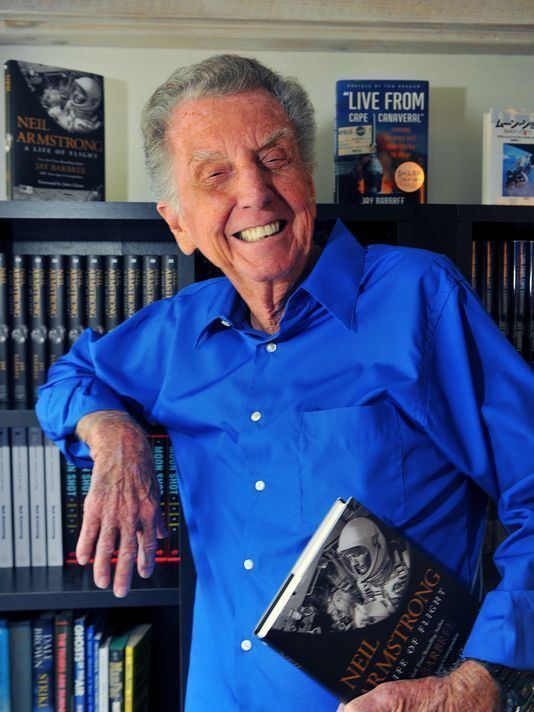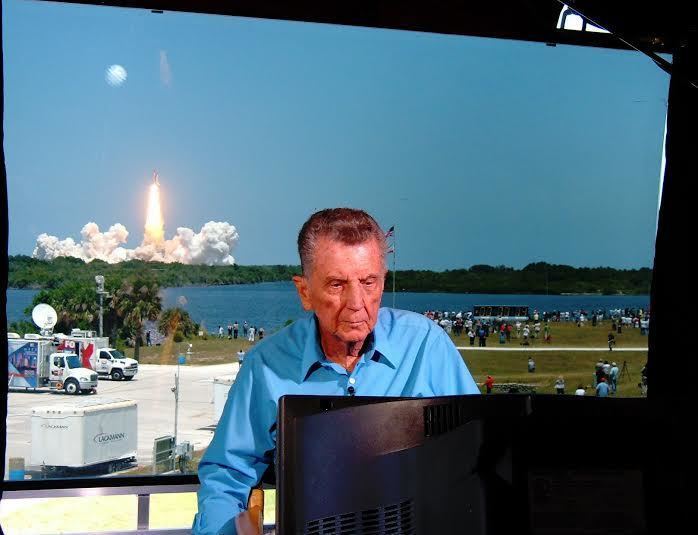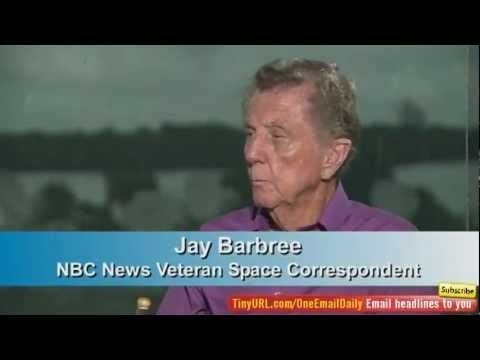Years active 50 Name Jay Barbree | Role Correspondent Spouse Jo Barbree (m. 1960) | |
 | ||
Occupation News broadcaster,reporter, author Awards 1995: NASA Award - for being the only journalist to have covered all 100 manned spaceflights. Children Karla Barbree, Steve Barbree, Alicia Barbree Books Neil Armstrong: A Life of F, Moon Shot: The Inside Story of A, The day I died, Six Million Dollar Man - Pilot Error, The Hydra Pit Similar People | ||
Older MSNBC Correspondent getting his groove on
Jay Barbree (born November 26, 1933) is a correspondent for NBC News, focusing on space travel. Barbree is the only journalist to have covered every manned space mission in the United States, beginning with the first American in space, Alan Shepard aboard Freedom 7 in 1961, continuing through to the last mission of the Space Shuttle, Atlantis's STS-135 mission in July 2011. Barbree has been present for all 135 space shuttle launches, and every manned launch for the Mercury, Gemini, and Apollo eras. In total, Barbree has been witness to 166 manned space launches.
Contents
- Older MSNBC Correspondent getting his groove on
- Book tv after words jay barbree neil armstrong a life of flight
- Early life
- Reporting career
- Career as author
- Personal life
- References

Book tv after words jay barbree neil armstrong a life of flight
Early life

Barbree grew up on his family's farm in Early County, Georgia, and entered the United States Air Force in 1950, when he was only 16 years of age. Following the Air Force, Barbree began his broadcast journalism career at WALB in Albany, Georgia where, in 1957, he saw Sputnik's spent booster rocket orbiting in the sky and then wrote radio and TV reports about the Soviet Union's launch of the first artificial satellite.
Reporting career

Barbree was so interested in the space program, that he paid for his own ticket to get to Cape Canaveral, Florida in 1957, and watched the attempted Vanguard launch. The failed launch was one Barbree would never forget: "There's ignition. We can see the flames," Barbree reported. "Vanguard's engine is lit and it's burning. But wait... wait a moment, there's... there's no liftoff! It appears to be crumbling in its own fire... It's burning on the pad... Vanguard has crumbled into flames. It failed ladies and gentlemen, Vanguard has failed."
Early the next year, he returned and witnessed the successful launch of Explorer 1 on January 31, 1958, all the while calling in his reports to WALB. Eventually, Barbree was hired by radio station WEZY in Cocoa Beach, and worked as a traffic reporter, covering the space program as well.
Six months later, Barbree joined NBC as a part-time space program reporter, eventually moving up to full-time. Over the years, Barbree had been offered the opportunity to move to Washington, D.C., or New York City, but he turned down every offer, preferring to stay and report on what had quickly become his passion, spaceflight.
"This is a job where … you have to be, whether you like it or not, a certain member of the space family."
In 1958, while in a restroom, Barbree overheard a general and a NASA official, talking about an upcoming launch called "Project SCORE", one of the earliest American satellites. This would become one of Barbree's many "scoops", when after a bit of digging, he found that President Dwight D. Eisenhower would use the satellite to broadcast a pre-recorded Christmas message from outer space. When SCORE launched in 1958, Barbree broadcast the story, knowing the military would not deny it once the satellite was in space.
In the early days of the space program, astronauts and reporters would often socialize together in Cocoa Beach, and had a very different relationship than they do today. Barbree described his relationship with the astronauts as a friend and confidant, often going out to dinner with them, or socializing together when the astronauts were in town. In his book, Barbree writes that in 1961 Alan Shepard told him an "off the record" fact: He was going to be the first American astronaut in space. Barbree noted that if he were to report this, it would not only jeopardize the friendships, but possibly his career as well, so he said nothing. Barbree also recounts a conversation with Gus Grissom about the astronaut’s concerns regarding Apollo not long before the fatal Apollo 1 fire. Barbree's association with the astronauts had some unexpected bonuses as well, Neil Armstrong carried a gold coin to the moon on Apollo 11 for Barbree, and Pete Conrad flew several flags and patches on Apollo 12, which Barbree later handed out to friends.
In the early 1980s, when NASA developed the Teacher in Space program, a similar program was developed, the Journalist in Space program. Barbree was one of forty finalists to be selected as a Journalist in Space. Both the teacher and journalist programs were discontinued after the Space Shuttle Challenger disaster.
In 1986, following the Space Shuttle Challenger accident, Barbree placed a telephone call to a friend and retired employee of NASA, who—as a favor to Barbree—went to Kennedy Space Center, looked over the accident information and analysis being done, and later reported the early findings to Barbree. Consequently, Barbree was the first journalist to report on the source of the destruction of the Space Shuttle Challenger: Faulty O-rings. He was also part of the NBC News Space Unit that won an Emmy award for NBC's coverage of the Apollo 11 moon landing. Following the Space Shuttle Columbia accident, Barbree was the first reporter to break the news of an internal NASA memo expressing concerns about foam striking the orbiter's left wing during ascent.
In 1995, NASA awarded him with recognition for being the "only journalist known to have covered all 100 flights". Among those present for the ceremony were several NASA officials, Alan Shepard, and shuttle commander Robert L. Gibson.
In 2011, Barbree was honored by the Space Foundation as a recipient of the Douglas S. Morrow Public Outreach Award in recognition of the role he played in shaping the way the nation views and understands space.
At age seventy-seven, Barbree is one of the longest-serving network correspondents to work continuously on a single subject. He started working for NBC on July 21, 1958 covering the space program, and continues in that capacity to the present. He has never missed a mission launch, despite suffering a heart attack while jogging along Cocoa Beach in 1987, and being declared clinically dead for several minutes. Following his heart attack, he had bypass surgery, and still did not miss any launches.
Barbree covers the shuttle program and space missions for the cable network MSNBC, and NBC's news reports covering missions. His contract with NBC runs through 2010, allowing him to complete the coverage of the entire space shuttle program, and he has expressed hope that he will be there for the return to the moon missions.
Career as author
Barbree is the author or coauthor of seven books, including two memoirs. In 1993, Shepard, fellow Mercury astronaut Deke Slayton, journalist Howard Benedict, and Barbree collaborated to write the book Moon Shot. Slayton was a participant in name only and died before the book was completed.
Barbree's most recent book, "Live from Cape Canaveral: Covering the Space Race, from Sputnik to Today", was released on August 28, 2007, to coincide with the 50th anniversary of spaceflight, that began with the Sputnik 1 launch on October 4, 1957. The foreword is written by Tom Brokaw. Barbree's book attempts to illustrate how the media has changed in their coverage of the space programs, from the early enthusiasm to the relative disinterest in the program today. Barbree says he wrote the book because as he looked back over his career, when recalling all the people he'd worked with, very few were left. Barbree claims that he told himself, "You're the only one who has covered the whole program going all the way back to the beginning, and if you don't tell the story, who is going to do it?" It received generally poor reviews from space historians.
Barbree also collaborated with Martin Caidin on a number of non-fiction works, such as Destination Mars: In Art, Myth and Science (Penguin, 1997, ISBN 978-0-670-86020-3) and A Journey Through Time: Exploring the Universe with the Hubble Space Telescope (Penguin, 1995, ISBN 0-670-86018-2). Barbree also wrote the novelization of "Pilot Error", an episode of The Six Million Dollar Man, a television series based upon Caidin's novel Cyborg (Warner, 1975, ISBN 0-446-76835-9).
Over the years, Barbree has stated that he has stayed away from sensationalizing the space program, or those associated with it, and commented that he would not put some items that could be considered harmful into his newest book, stating "The whole idea of the book is not to hurt somebody." Barbree attempts to illustrate this in his memoir by telling of a private investigator who approached him with an audio tape which allegedly contained proof of an extramarital affair involving an astronaut. Barbree told the investigator he would speak to his superiors, but then proceeded to erase the tape.
Personal life
Barbree has been married since 1960 to the former Jo Reisinger, whom he met while covering her participation in Florida beauty pageants. They live in Merritt Island. They have three children, Steve, Alicia, and Karla. Their son Scott died in infancy following a premature birth.
